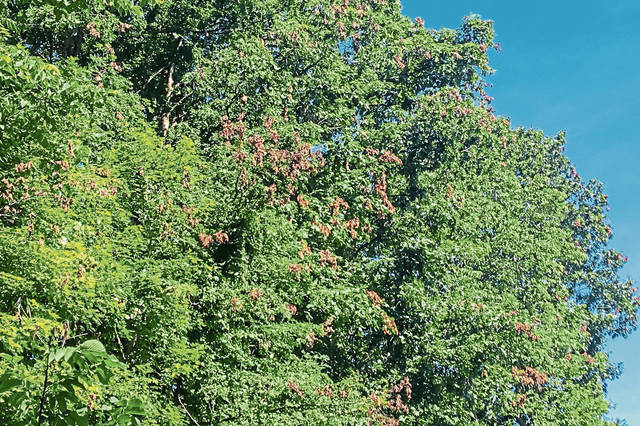https://triblive.com/local/regional/periodical-cicadas-perform-natural-pruning-on-trees-across-western-pennsylvania/
Periodical cicadas perform 'natural pruning' on trees across Western Pennsylvania

Drive through nearly any part of rural Western Pennsylvania and it won’t take long to notice: little clumps of dead leaves at the ends of certain tree branches.
Fall hasn’t arrived early.
The phenomenon is called “flagging” and is the work of the periodical cicadas from Brood VIII, who emerged this spring and will return next in 2036.
“The female cicada lays her eggs right at the end of the branches,” said Gene Kritsky, dean of behavioral and natural sciences at Mount St. Joseph University in Ohio. “She does that using an ovipositor, which actually saws into the branch. And if you have a lot of cicadas vying for egg-laying space, it can stop water from flowing up the branch to the leaves.”
As a result, many of the region’s deciduous trees in particular seem to have sprouted little brown pom-poms.
“They tend to prefer deciduous trees like oaks and apples, compared to conifers,” Kritsky said.
And while cicadas may not like conifers, they’re not particular: cicadas have been reported on more than 200 species of trees and shrubs.
Much of that reporting has been done through Cicada Safari, a cellphone app Kritsky and others at Mount St. Joseph have developed.
App users can record the time, date and location a cicada is spotted and send a photograph along with the information.
“With that, we were able to verify about 6,000 photographs from eastern Ohio, northern West Virginia and Western Pennsylvania,” Kritsky said. “We were able to get a really good sense of where the cicadas were and how extensively they appeared.”
Apart from an occasional dead specimen, this year’s Brood VIII cicadas are largely gone, noticeable only by the flagging tree branches where nymphs will soon drop to the ground, dig in and begin their 17-year nap.
And while flagging isn’t pretty, it is beneficial to the trees.
“It’s actually sort of a natural pruning,” Kritsky said. “Trees with those branch breaks will actually produce more flowers the following year.”
In the 1890s, Kritsky said, a paper studying the effect of cicadas on cherry trees was published titled, “Out of Evil Cometh Good.”
“They discovered that the year after a cicada emergence, cherry trees did better,” he said.
Through data collected from the app, Kritsky and his colleagues were able to verify a few cicada-related outliers this year.
“We saw some Brood IV cicadas who came out in Kansas about four years late, and some Brood X members who came out a few years early in Ohio,” he said. “Right now, we’re transitioning the app to monitor annual cicadas, the green ones that come out. Hopefully, we can get a better sense of where and when they’re popping up.”
Kritsky said more than 8,700 people have downloaded the free app, which is available through the Apple and Google app stores.
Copyright ©2025— Trib Total Media, LLC (TribLIVE.com)
